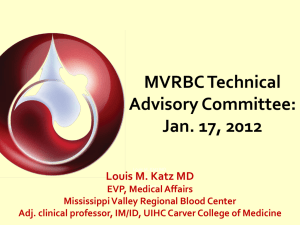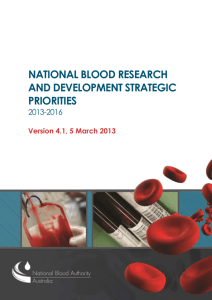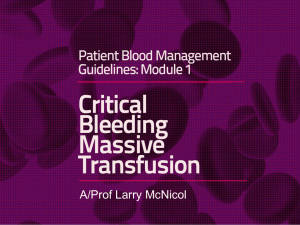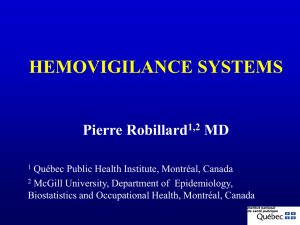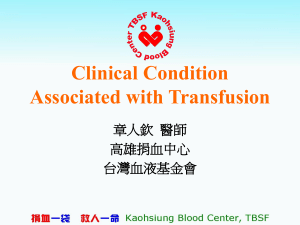Standard 7 – Blood and Blood products
advertisement
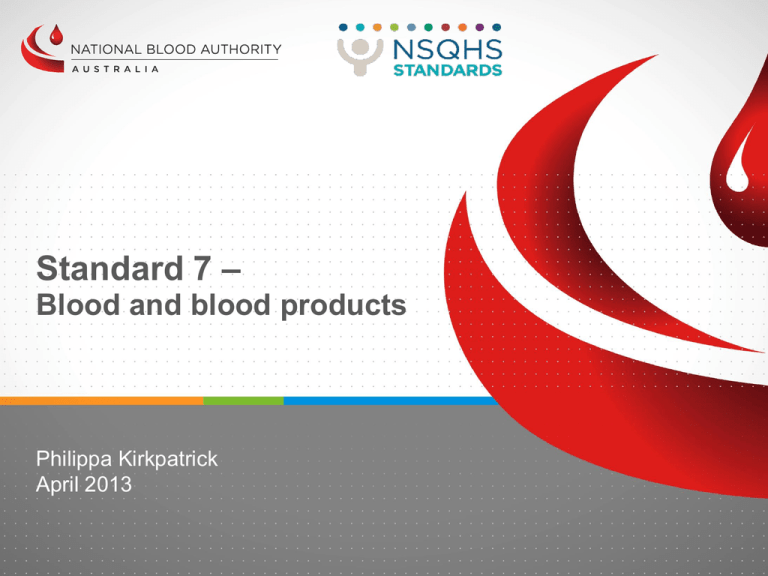
Standard 7 – Blood and blood products Philippa Kirkpatrick April 2013 Why a blood standard? • There are inherent risks associated with transfusion practice • Transfusion has been associated with increased morbidity and mortality • Transfusion is ingrained in the culture of medical practice • Reports suggest a significant proportion of transfusions are inappropriate • There are high wastage rates at some health service organisations • There is significant room for improvement in practice to improve quality and safety Scope - activities • The Blood Standard covers: Use of blood and blood products – the prescribing practice and clinical use of blood and blood products, and whether or not those products are prescribed and used appropriately Management of blood and blood products - handling, transport, storage (including inventory management) of blood and blood products Administration of blood and blood products - the process used to deliver the product to the patient. Scope Classes of products funded under National Blood Arrangements Currently covered by Standard 7 Fresh blood products eg • • • • • Red cells Platelets Plasma Cryoprecipitate Serum eye drops Plasma derived products eg • • • IVIg RhD immunoglobulin Clotting factors Recombinant clotting factors Classes of products not funded under National Blood Arrangements Not currently covered by Standard 7 Haematopoietic progenitor cells Blood Plasma derived products eg • • • • Tisseel Artiss C1-INH Fibrinogen • Monoclonal antibodies • Vaccines • Other recombinant products Biological Medicine Three main areas of concern • Decision-making regarding the clinical use of blood components • Patient identification and labelling of pre-transfusion specimens • Bedside verification that the correct blood is given to the intended recipient *Source: Haemovigilance Report 2010 Criterion One Governance and systems Transfusion quality improvement system (Action 7.4.1) Improve documentation of transfusion (7.5.3) Improve quality and use of policies (7.1.3) Reduce management risks (7.7.2) Reduce adverse event risks (7.3.1) Reduce systems risks (7.2.2) Reduce wastage (7.8.2) Reduce administration risks (7.6.2) Improve provision of information to patients (7.10.1) Improve documentation of consent (7.11.1) Policies, procedures and protocols (Action 7.1.1) • You should have policies, procedures and protocols that reflect best practice, and national evidence based guidelines where they are available. • Your policies, procedures and protocols should cover the spectrum of: – Use of blood and blood products – Management of blood and blood products – Administration of blood and blood products Quality improvement cycle Identify what you will do - develop or identify policies, procedures or protocols Plan Take action to improve uptake and improve their quality Act Transfusion Quality Improvement System Do Implement the policies Check Monitor their use AND monitor their quality Transfusion governance group (Action 7.4.1) • Oversight of the program – Review reports – Identify recurring issues What about small organisations? – Root cause analysis of incidents – Develop or agree action plan – Evaluate effectiveness of actions Consider alignment and linkages with Standard One Criterion Two Documenting patient information The patient clinical record (Action 7.5.1) • A best possible history of blood product usage and relevant clinical and product information is documented in the patient clinical record • This action builds on Action 1.9.1 by identifying the information relevant to transfusion of blood and blood products that should be documented Patient documentation case study What actions are required to demonstrate compliance with the Standard? Case Study Hospital One • Transfusion governance group has reviewed findings and developed and implemented an action plan, for example: – Reviewed policy – Implemented training of all staff – Identified staff associated with non-compliance and communicated directly with them – Made changes to the IT system to facilitate inclusion of all information (prompts) – Increased frequency of audit on the hospital audit plan – Initiated more regular spot checks of fate of product against patient records Outcome: the action plan is matched with the level of compliance. This would be likely be assessed as meeting the requirement, but the health service organisation should also demonstrate improvement in next cycle. Case Study Hospital One • Audit report does not have a management response or action plan • They posted on the intranet a reminder to document transfusion in the patient clinical record • They have not undertaken any other follow up and the next audit is scheduled for one year away Outcome: the action plan is not matched with the level of compliance. The health service organisation needs to demonstrate additional work prior to accreditation. Case Study Hospital Two • They posted on the intranet a reminder to document transfusion in the patient clinical record • They have not undertaken any other follow up and the next audit is scheduled for one year away Outcome: the action plan is matched with the level of compliance. This would be likely to be assessed as meeting the requirement. Managing adverse events • Recognise and respond to adverse events • Document adverse events in the patient clinical record • Take action to reduce the risk of adverse events as part of your transfusion quality improvement system Complexities of incident monitoring and reporting Patient record External report 7.6.1 – Document in patient clinical record 7.6.3.- Report to pathology service provider, Blood Service or product manufacturer whenever appropriate Local report 7.3.1. - Report in local incident system and review by Transfusion Governance Group Exec review 7.3.2. - Review by highest governance level of incident summary and analysis State report National report 7.3.3. – Participate in state haemovigilance reporting In some cases will be extracted from local system or, may require reporting to the state system 7.3.3 – Participate in national haemovigilance reporting In some cases will be extracted from state system or, may require reporting to the national system Criterion Three Managing blood and blood product safety Management of blood and blood products • Blood must be stored and handled appropriately to prevent risk to patients. Systems should be implemented to reduce risks associated with receipt, storage, collection, and transport (Action 7.7.1 and 7.7.2) • Wastage of blood should be minimised (Action 7.8.1 and 7.8.2) Responsibility where services are outsourced • Many health service organisations receive blood from an outsourced pathology • It remains the health service organisation’s responsibility to demonstrate compliance with the Standard A health service organisation uses blood provided by a contracted pathology provider Your health service organisation should have a contract with the pathology provider that includes requirements and provision of reports to enable hospital to check they meet the standards Your health service organisation should review reports provided and implements strategies with contracted pathology provider to rectify problems Criterion Four Communicating with patients and carers Communication (Actions 7.9.1, 7.9.2 and 7.10.1) • Develop or identify resources to inform patients and their carers about the alternatives, risk and benefits of transfusion (Action 7.9.1) • Provide this information to patients and their carers in a format that is understood and meaningful (7.10.1) • Allow patients and carers to partner in decisions on their care based on the communication on the alternatives, risks and benefits of transfusion (Action 7.9.2) Consent (Action 7.11.1) • Have a documented consent policy which is specific to, or includes transfusion of blood and blood products • Ensure written and documented consent meets local policy • Ensure the consent is actually informed – link with 7.9 and 7.10 • Assess compliance with the consent policy is assessed, and take actions to increase compliance Resources Available resources Clinical practice guidelines National Blood Authority www.blood.gov.au/guidelines Patient Blood Management Guidelines Module 1: Critical Bleeding Massive Transfusion Module 2: Perioperative Module 3: Medical Module 4: Critical Care Module 5: Obstetric Module 6: Paediatric/Neonates Guidelines on the Prophylactic Use of Rh D Immunoglobulin (anti-D) in Obstetrics Criteria for the Clinical Use of Intravenous Immunoglobulin (second edition) NHMRC guidelines portal www.nhmrc.gov.au/guidelines Factor VIII and FIX Guidelines Warfarin Reversal Consensus Guidelines Australian and New Zealand Society of Blood Transfusion (ANZSBT) guidelines and publications www.anzsbt.org.au/publications/ Available resources Product information and product management 10 Tips to Help Manage you Blood Product Inventory http://www.nba.gov.au/supply/10-tips.pdf Managing blood and blood product inventory – Guidelines for Australian Health Providers http://www.nba.gov.au/supply/inventory-guidelines.pdf Australian Red Cross Blood Service Blood Component Information Circular http://www.transfusion.com.au/sites/default/files/BCI%202012.pdf The Australian Red Cross Blood Service blood components and products web site http://www.transfusion.com.au/blood_products BloodSafe eLearning Australia module on Transporting Blood https://www.bloodsafelearning.org.au/ ANZSBT Guidelines for the Administration of Blood Products http://www.anzsbt.org.au/publications/ ANZSBT Guidelines for Pre-Transfusion Laboratory Practice http://www.anzsbt.org.au/publications/ National Pathology Accreditation Advisory Council (NPAAC) Requirements for Transfusion Laboratory Practice http://www.anzsbt.org.au/news/documents/07NPAACReqforTLP.pdf Australian Standard for Medical Refrigeration Equipment – For the Storage of Blood and Blood Products (AS3864) http://infostore.saiglobal.com/store/Details.aspx?ProductID=1600490 NBA BloodNet http://www.blood.gov.au/bloodnet/ NBA BloodPortal https://portal.blood.gov.au/ Flippin’ Blood http://www.transfusion.com.au/sites/default/files/Flippin%20Blood%20ONLINE.pdf Available resources Adverse event recognition and reporting See Jurisdictional programs NBA Haemovigilance Reports 2008 http://www.blood.gov.au/haemovigilance/ National Haemovigilance Data Dictionary http://www.blood.gov.au/haemovigilance/ Flippin’ Blood http://www.transfusion.com.au/sites/default/files/Flippin%20Blood%20ONLINE.pdf ANZSBT Guidelines for the Administration of Blood Products(http://www.anzsbt.org.au/publications/) Patient information and consent See Jurisdictional programs The Australian Red Cross Blood Service – Information for Patients www.mytransfusion.com.au Jurisdictional Programs New South Wales – Blood Watch http://www.cec.health.nsw.gov.au/programs/blood-watch Queensland iBlood Management Program http://www.health.qld.gov.au/qhcss/qbmp/ South Australia – BloodSafe http://www.health.sa.gov.au/bloodsafe/ Victoria – Blood Matters http://www.health.vic.gov.au/bloodmatters/ Western Australia Patient Blood Management Program http://www.health.wa.gov.au/bloodmanagement Thank you www.blood.gov.au





